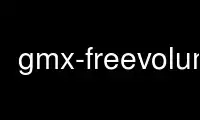
This is the command gmx-freevolume that can be run in the OnWorks free hosting provider using one of our multiple free online workstations such as Ubuntu Online, Fedora Online, Windows online emulator or MAC OS online emulator
PROGRAM:
NAME
gmx-freevolume - Calculate free volume
SYNOPSIS
gmx freevolume [-f [<.xtc/.trr/...>]] [-s [<.tpr/.gro/...>]]
[-n [<.ndx>]] [-o [<.xvg>]] [-b <time>] [-e <time>]
[-dt <time>] [-tu <enum>] [-xvg <enum>] [-[no]rmpbc]
[-sf <file>] [-selrpos <enum>] [-select <selection>]
[-radius <real>] [-seed <int>] [-ninsert <int>]
DESCRIPTION
gmx freevolume calculates the free volume in a box as a function of time. The free volume
is plotted as a fraction of the total volume. The program tries to insert a probe with a
given radius, into the simulations box and if the distance between the probe and any atom
is less than the sums of the van der Waals radii of both atoms, the position is considered
to be occupied, i.e. non-free. By using a probe radius of 0, the true free volume is
computed. By using a larger radius, e.g. 0.14 nm, roughly corresponding to a water
molecule, the free volume for a hypothetical particle with that size will be produced.
Note however, that since atoms are treated as hard-spheres these number are very
approximate, and typically only relative changes are meaningful, for instance by doing a
series of simulations at different temperature.
The group specified by the selection is considered to delineate non-free volume. The
number of insertions per unit of volume is important to get a converged result. About
1000/nm^3 yields an overall standard deviation that is determined by the fluctuations in
the trajectory rather than by the fluctuations due to the random numbers.
The results are critically dependent on the van der Waals radii; we recommend to use the
values due to Bondi (1964).
The Fractional Free Volume (FFV) that some authors like to use is given by 1 - 1.3*(1-Free
Volume). This value is printed on the terminal.
OPTIONS
Options to specify input files:
-f [<.xtc/.trr/...>] (traj.xtc) (Optional)
Input trajectory or single configuration: xtc trr cpt gro g96 pdb tng
-s [<.tpr/.gro/...>] (topol.tpr) (Optional)
Input structure: tpr gro g96 pdb brk ent
-n [<.ndx>] (index.ndx) (Optional)
Extra index groups
Options to specify output files:
-o [<.xvg>] (freevolume.xvg) (Optional)
Computed free volume
Other options:
-b <time> (0)
First frame (ps) to read from trajectory
-e <time> (0)
Last frame (ps) to read from trajectory
-dt <time> (0)
Only use frame if t MOD dt == first time (ps)
-tu <enum> (ps)
Unit for time values: fs, ps, ns, us, ms, s
-xvg <enum> (xmgrace)
Plot formatting: none, xmgrace, xmgr
-[no]rmpbc (yes)
Make molecules whole for each frame
-sf <file>
Provide selections from files
-selrpos <enum> (atom)
Selection reference positions: atom, res_com, res_cog, mol_com, mol_cog,
whole_res_com, whole_res_cog, whole_mol_com, whole_mol_cog, part_res_com,
part_res_cog, part_mol_com, part_mol_cog, dyn_res_com, dyn_res_cog, dyn_mol_com,
dyn_mol_cog
-select <selection>
Atoms that are considered as part of the excluded volume
-radius <real> (0)
Radius of the probe to be inserted (nm, 0 yields the true free volume)
-seed <int> (-1)
Seed for random number generator.
-ninsert <int> (1000)
Number of probe insertions per cubic nm to try for each frame in the trajectory.
Use gmx-freevolume online using onworks.net services
